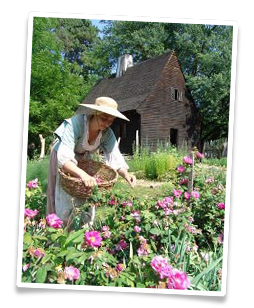Gardens at Historic St. Mary’s City
Many species of native plants are represented on the grounds of HSMC. The ancient street pattern now serves as a visitor walking path and ties together various garden areas.
 The Garden at Farthing’s Ordinary is a labeled display garden which gives the visitor an overview of what to expect at the other exhibits. The beds are divided thematically into plants brought over by the colonists, plants cultivated by the American Indians, and native plants that may have been wild collected. A handout with more information is available at the site. This garden is adjacent to an arbor that features old rose varieties and an orchard of antique apple, cherry and peach trees.
The Garden at Farthing’s Ordinary is a labeled display garden which gives the visitor an overview of what to expect at the other exhibits. The beds are divided thematically into plants brought over by the colonists, plants cultivated by the American Indians, and native plants that may have been wild collected. A handout with more information is available at the site. This garden is adjacent to an arbor that features old rose varieties and an orchard of antique apple, cherry and peach trees.
The Visitor Center on Rosecroft Road and the Freedom of Conscience Monument on Route 5 both feature “Bayscapes” type gardens. These focus on native plants, including perennials, shrubs and grasses that make up the plant palette of the coastal plain. Even the parking lot islands follow this theme, using only native species. You may enjoy the gardens at the Monument, Visitor Center, or Farthings without purchasing admission to the museum.
 The year of contact, 1634, is interpreted at the Woodland Indian Hamlet.It features a Three Sisters garden of corn, beans and squash, a tobacco planting, and a small English garden, all surrounded by the native environment.
The year of contact, 1634, is interpreted at the Woodland Indian Hamlet.It features a Three Sisters garden of corn, beans and squash, a tobacco planting, and a small English garden, all surrounded by the native environment.
Smith’s Ordinary at the Town Centerhas a small garden area consisting of seven raised beds containing various herbs and vegetables.
 The Godiah Spray Plantation Garden is a much more complete kitchen garden which includes not only food crops, but also the herbs used for cooking, healing, and various household tasks. Heirloom varieties of vegetables mingle with the traditional and more unusual herbs so vital to a 17th -century household. This garden is interpreted in the first person by costumed staff who have assumed the roles of 17th-century personalities. Tobacco and corn are grown in adjacent fields and rare breeds of chicken, cow, and pig complete the plantation scene.
The Godiah Spray Plantation Garden is a much more complete kitchen garden which includes not only food crops, but also the herbs used for cooking, healing, and various household tasks. Heirloom varieties of vegetables mingle with the traditional and more unusual herbs so vital to a 17th -century household. This garden is interpreted in the first person by costumed staff who have assumed the roles of 17th-century personalities. Tobacco and corn are grown in adjacent fields and rare breeds of chicken, cow, and pig complete the plantation scene.
The Margaret Brent Garden has become a park-like area featuring wonderful old boxwoods.
The museum also includes a 3 ½ mile walking trail that traverses woods, field edges, and riverside. Trail guides are available.


